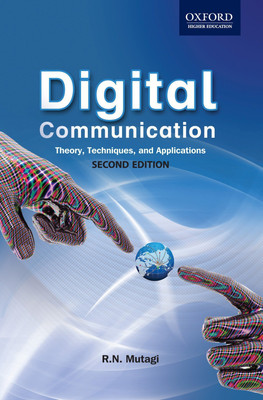Digital Communication: Theory, Techniques and Applications (2e)(English, Paperback, Mutagi R N)
Quick Overview
Product Price Comparison
Digital Communication: Theory, Techniques, and Applications is designed for undergraduate students of engineering for a course on digital communication. The second edition of this book treats spread spectrum communication techniques as an exclusive chapter. The book starts from the basics of signals and systems and builds the preliminary concepts through the chapters on probability and random processes, and information theory. It then goes on to describe core concepts such as digital coding, multiplexing and multiple access, modulation techniques, demodulation, error control coding, and spread spectrum communication. The last chapter illustrates the concepts learnt in the earlier chapters through applications in optical, satellite, and wireless communication domains. Salient Features Discusses latest compression standards, such as DAB, MPEG, H.264, and MP3 Provides around 140 graded solved problems, review questions, and challenging exercises for practice Includes a detailed laboratory manual (Appendix D) with procedure, observation table, questions, and MATLAB codes to help in simulating many theoretical functions New to the Second Edition Treats spread spectrum communication as an exclusive chapter Includes new sections on pulse width modulation (PWM), pulse position modulation (PPM), burst synchronization, voice codecs, and combo chips Provides new solved problems, review questions, and exercises Includes hints (final answers) to all relevant exercise problems (Appendix G) Online Resources The following resources are available to support the faculty using this text: Solutions Manual PowerPoint Slides About the Author R.N. Mutagi is Professor and Head, Department of Electronics and Communication Engineering, Indus Institute of Technology and Engineering, Ahmedabad. He has also taught courses on digital communication, telecommunication, wireless systems, and project management at the Algonquin College in Ottawa, Canada. He is a senior member of the Institute of Electrical and Electronics Engineers (IEEE) Communication Society and Signal Processing Society, fellow of the Broadcast Engineering Society (BES), and fellow of the Institute of Electronics and Telecommunication Engineers (IETE). Having around four decades of experience in the industry, Prof. Mutagi has been associated with the development of satellite communication systems at the Indian Space Research Organization (ISRO), including the satellite instructional television experiment (SITE), satellite telecommunication experiment project (STEP), APPLE utilization programme (AUP), and geostationary satellite (GSAT). About the Author Chapter 1. Introduction to Digital Communication Systems Chapter 2. Communication Signals and Systems Chapter 3. Probability and Random Processes Chapter 4. Information Theory Chapter 5. Digital coding Chapter 6. Multiplexing and Multiple Access Chapter 7. Digital modulation Chapter 8. Demodulation and Detection Chapter 9. Error Control Coding Chapter 10. Spread Spectrum Communication Chapter 11. Applications of Digital Communication Appendices Bibliography Index About the Author


